Difficulty: Low
Duration: 2 hours and a half
The Foppe area can be easily reached from Nadro village (Ceto), where visitors will find the ticket office, the didactic Museum and the documentation centre (check the information here).
Foppe di Nadro is marked by a very high concentration of engraved rocks, often of large dimensions and densely carved. The iconography of the whole area, particularly rich for the quality and variety of its themes, has not been completely analysed yet, though over the years several studies have been published about single rocks or their main subjects. In addition to the extraordinary Iron Age engravings, it is worth to mention the frequency of praying figures and, especially, the uncommon abundance of Copper Age petroglyphs (Remedellian-type daggers, ploughing scenes with cattle, “topographic” compositions), being this latter a range of subjects usually quite rare on rock surface, while typical of the coeval statue-stelae phenomenon.
The visiting route, stretching in a ring path, allows visitors to access about 23 engraved rocks (from the 81 recorded up to now in the area). In order to have a basic comprehension of the peculiarities of the territory, we recommend the vision of R. 1, 4, 6–7, 22–23, 24, 27–26, 30, and 36.
Once left the Nadro Museum, the first carved rocks on the route can be reached after an about 10-minute walk northward, along the cobbled road that in ancient times was called “Strada delle Aquane”.
Trail details

LENGTH: 2.8 Km (roundtrip)
ALTITUDE: Max 500 m – Min 430 m
DIFFERENCE IN ALTITUDE: 70 m
KIND OF PATH: Unpaved hiking trail
DIFFICULTY: Easy
For the link to the trail, click here
Virtual Tour
Foppe R1
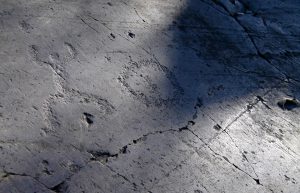
It is a quite small surface, smoothed by the glacier action. Its lower part is carved with several praying figures, sometimes surrounded by symbols such as rings (perhaps solar discs?), while the upper part is marked by a noteworthy concentration of Iron Age figures, mainly composed of anthropomorphic ones. On the other hand, the Christian crosses on the left border of the prehistoric panel constitute undisputable evidence of the continuous engraving activity of the local population, even during historic times.
Foppe R6-7
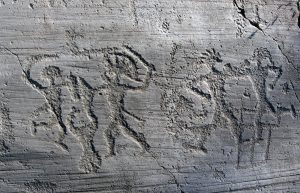 Among the richest and most famous engraved surfaces of the entire Valcamonica, R6-7 gives testimony to the artistic apex reached by the Camunian people during the Iron Age period (to which almost all the engravings on this rock can be traced back). Apart from the warriors, the figures on this rock represent some extremely characteristic themes of Valcamonica rock art, among which are many huts and, most importantly, hundreds of footprints. The meaning of the latter has been connected with initiation rituals of the noble warrior classes, but it could also represent a sort of ex-voto – similarly to the ones known during the Roman age. R6-7 also has many bird figures (a recurring theme in this area) and in its lower part there are some exceptional depictions: among them, two five-pointed stars, writings in “Camunian alphabet” (a variant of the North-Etruscan one), and two fighting scenes (armed duel and boxing), which remind similar themes from the Italic art of the same period (Rhaetic bronze statuettes, Venetian Situlae art, Etruscan paintings).
Among the richest and most famous engraved surfaces of the entire Valcamonica, R6-7 gives testimony to the artistic apex reached by the Camunian people during the Iron Age period (to which almost all the engravings on this rock can be traced back). Apart from the warriors, the figures on this rock represent some extremely characteristic themes of Valcamonica rock art, among which are many huts and, most importantly, hundreds of footprints. The meaning of the latter has been connected with initiation rituals of the noble warrior classes, but it could also represent a sort of ex-voto – similarly to the ones known during the Roman age. R6-7 also has many bird figures (a recurring theme in this area) and in its lower part there are some exceptional depictions: among them, two five-pointed stars, writings in “Camunian alphabet” (a variant of the North-Etruscan one), and two fighting scenes (armed duel and boxing), which remind similar themes from the Italic art of the same period (Rhaetic bronze statuettes, Venetian Situlae art, Etruscan paintings).
Foppe R4
 This is a small but densely engraved surface, mainly carved during the Copper Age (3,300-2,200 BCE) and the Early Bronze Age (2,200-1,800 BCE). For the most part, its engravins are almost life-size dagger figures. The wealth of detail allows researchers to compare these depictions with similar silhouettes from the local statue-stelae and also from the nearby R22. Real-life specimens of these daggers, with a triangular copper blade and half-moon or semicircular pommel, were found by archaeologists in the necropolis of Remedello (Brescia, Italy), during the excavations carried out in the early 20th century. Some shapes, with a narrower and more elongated blade, suggest instead a chronological placement in the early 2nd millennium BC. A pair of duelists on the left, according to E. Anati, belongs instead to the transitional period between the Bronze Age and the Iron Age (c. 1,200 to 1,000 BCE).
This is a small but densely engraved surface, mainly carved during the Copper Age (3,300-2,200 BCE) and the Early Bronze Age (2,200-1,800 BCE). For the most part, its engravins are almost life-size dagger figures. The wealth of detail allows researchers to compare these depictions with similar silhouettes from the local statue-stelae and also from the nearby R22. Real-life specimens of these daggers, with a triangular copper blade and half-moon or semicircular pommel, were found by archaeologists in the necropolis of Remedello (Brescia, Italy), during the excavations carried out in the early 20th century. Some shapes, with a narrower and more elongated blade, suggest instead a chronological placement in the early 2nd millennium BC. A pair of duelists on the left, according to E. Anati, belongs instead to the transitional period between the Bronze Age and the Iron Age (c. 1,200 to 1,000 BCE).
Foppe R21

This is a rather small rock, engraved with many praying figures and rare daggers (Remedellian type). Its most noteworthy engravings are a scenic ensemble with schematic anthropomorphs interspersed with cup-marks (perhaps a ceremony?), recalling – in composition but not in form – similar examples from the statue-stelae from Cemmo (Valcamonica), belonging to the Late Copper Age (c. 2,400-2,200 BCE), and a large classical figure in the shape of an armed orant, with a crested helmet and (highly stylized) sword and shield.
Foppe R22
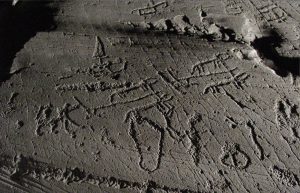
Rock 22 is fundamental to the study of the period spanning between the end of the 4th and the beginning of the 2nd millennium BCE – a delicate and crucial phase for Western Europe and Italy, during which metallurgy and agriculture arrived and then consolidated. The surface of R22 shows a double ploughing scene, once again referring back to the compositions on the statue-stelae; similarly, this scene was associated with a set of daggers with a crescent-shaped pommel (in some cases adorned with small studs) and a triangular blade.
Foppe R23
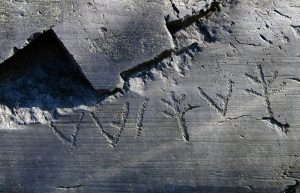 This wide and elongated surface is a natural morphological continuation of R22. Its Southeast-facing portion shows a rare composition of axe figures, comparable with other weapons of the same type, dated to the Early Bronze Age (2,200-1,800 BCE). In the lower sector there is an inscription in the so-called Camunian (or Sondrio) alphabet, a Central-Alpine variant of a North-Etruscan writing system. The inscription, right-handed, shows the characteristic Camunian “Z” (in the shape of a sapling) and an inverted “A,” reading “ZAZIAU” (it is read from right to left). The introduction of writing in Valcamonica can be placed around the 5th century BCE.
This wide and elongated surface is a natural morphological continuation of R22. Its Southeast-facing portion shows a rare composition of axe figures, comparable with other weapons of the same type, dated to the Early Bronze Age (2,200-1,800 BCE). In the lower sector there is an inscription in the so-called Camunian (or Sondrio) alphabet, a Central-Alpine variant of a North-Etruscan writing system. The inscription, right-handed, shows the characteristic Camunian “Z” (in the shape of a sapling) and an inverted “A,” reading “ZAZIAU” (it is read from right to left). The introduction of writing in Valcamonica can be placed around the 5th century BCE.
Foppe R28
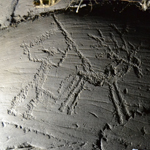 This small mounded rock is the natural continuation of R22-23, from which it is separated by deep billowing. Its summit part shows characteristic fractures and flaking, probably due to the lighting of fires bordered by cured, large cup-marks. There are also hammered areas of topographic type, ploughing scenes, two daggers (one attributable to the Copper Age and one to the Bronze Age), figures of armed men, a deer hunt scene, a ridden deer, a square-bladed axe, a finely crafted bovine, building figures (huts).
This small mounded rock is the natural continuation of R22-23, from which it is separated by deep billowing. Its summit part shows characteristic fractures and flaking, probably due to the lighting of fires bordered by cured, large cup-marks. There are also hammered areas of topographic type, ploughing scenes, two daggers (one attributable to the Copper Age and one to the Bronze Age), figures of armed men, a deer hunt scene, a ridden deer, a square-bladed axe, a finely crafted bovine, building figures (huts).
Foppe R24
 It is a large, smooth surface with engravings distributed in four main sectors. In the middle part, just above the walkway, there are numerous hut figures (about 30), probably of symbolic value: they are depicted in different sizes and types, and are attributable to the Iron Age. Still in the middle part, just below the walkway, there are many Iron Age figures (1st millennium BCE), including a figure with a long robe and flute, numerous duelling warriors, armed “dancers” with radiated helmets, and Camunian roses. Partially subjected to the hammer figures are many filiform technique engravings, including numerous writings (among which two complete alphabetical series), Introbio-Lovere type daggers (2nd cent. BCE- 1st cent. AD), reticles, etc.
It is a large, smooth surface with engravings distributed in four main sectors. In the middle part, just above the walkway, there are numerous hut figures (about 30), probably of symbolic value: they are depicted in different sizes and types, and are attributable to the Iron Age. Still in the middle part, just below the walkway, there are many Iron Age figures (1st millennium BCE), including a figure with a long robe and flute, numerous duelling warriors, armed “dancers” with radiated helmets, and Camunian roses. Partially subjected to the hammer figures are many filiform technique engravings, including numerous writings (among which two complete alphabetical series), Introbio-Lovere type daggers (2nd cent. BCE- 1st cent. AD), reticles, etc.
Foppe R36
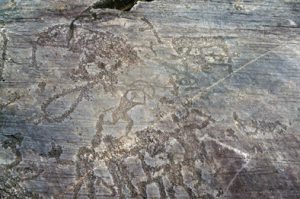 This small surface was densely historiated during different phases of the Iron Age (1st millennium BC). Of particular interest are a dynamic and elegant archer figure, a fawn figure, and an anecdotal scene on the upper end, in which a figure appears to be leaning on a staff. Anthropomorphs, animals, footprints and some buildings are the other hammered figures depicted on this rock, flanked by a few filiform ones.
This small surface was densely historiated during different phases of the Iron Age (1st millennium BC). Of particular interest are a dynamic and elegant archer figure, a fawn figure, and an anecdotal scene on the upper end, in which a figure appears to be leaning on a staff. Anthropomorphs, animals, footprints and some buildings are the other hammered figures depicted on this rock, flanked by a few filiform ones.
Foppe R26-27
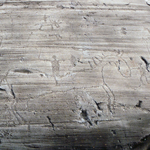 The rock complex called R26-27 constitutes one of the highest concentrations of rock art in the area, among the largest engraved rocks in the entire Valcamonica. R26 – its Easternmost surface portion – is characterized by an abundance of square-bladed axes (7th-5th cent. BCE), a quite an unfrequent theme in Foppe di Nadro (instead common in the Campanine area, above Foppe). The Westernmost portion is called R27: this part is characterized by numerous Middle and Late Iron Age figures, including many armed and dueling figures, canids, deer, the so-called “Nadro temple” (a complex building depiction with numerous symbols attached), concentric circles, shovels, footprints and other geometric signs. Prominent among the various peculiarities of the surface is the figure of the large horse with rider and squire, testifying to the extraordinary importance given to the mount during the Iron Age. Moreover, it also seems to highlight a precise differentiation of roles in the distinction between the rider, armed with shield and spear (perhaps a Camunian princeps?), and the “squire”, bearer of the rider’s spear and dismounted driver of the steed.
The rock complex called R26-27 constitutes one of the highest concentrations of rock art in the area, among the largest engraved rocks in the entire Valcamonica. R26 – its Easternmost surface portion – is characterized by an abundance of square-bladed axes (7th-5th cent. BCE), a quite an unfrequent theme in Foppe di Nadro (instead common in the Campanine area, above Foppe). The Westernmost portion is called R27: this part is characterized by numerous Middle and Late Iron Age figures, including many armed and dueling figures, canids, deer, the so-called “Nadro temple” (a complex building depiction with numerous symbols attached), concentric circles, shovels, footprints and other geometric signs. Prominent among the various peculiarities of the surface is the figure of the large horse with rider and squire, testifying to the extraordinary importance given to the mount during the Iron Age. Moreover, it also seems to highlight a precise differentiation of roles in the distinction between the rider, armed with shield and spear (perhaps a Camunian princeps?), and the “squire”, bearer of the rider’s spear and dismounted driver of the steed.
R26-27 is undoubtedly one of the most important surfaces in the area, in terms of number and quality of engraved figures: it is covered in thousands of them, scattered over tens of square meters of emergent rock. Virtually, it bears all the iconography of Valcamonica rock art (warriors, huts, footprints, five-pointed stars, inscriptions, etc.), with exceptional examples in certain categories. Particularly noteworthy, apart from the already mentined “Nadro temple”, are the scene of the so-called “Butterfly Idol” – in which a winged orant seems to hover above a second, classically anthropomorphic orant – and the panel with a human figure placed in front of seven dogs in the central portion of the rock. Scattered here and there are concentrations of other figures or specific themes, including some “open-bodied” horses, birds that are similar to those on R5-6-7, a graffitied Solomon’s knot, and many square-bladed axes. The engraving activity on this rock covers a chronological span from the Neolithic period to the Iron Age.
Foppe R29
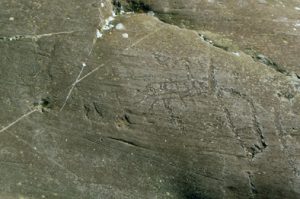 This large rocky outcrop is the Southern continuation of R27. Its carvings are distributed over different panels, created by the rugged morphology of the rock surface. Some themes, such as duelling schematic human figures and depictions of dogs, relate back to the contiguous scenes on R27, while other elements represent a true unicum. Particularly noteworhty here are a swastika figure, a Camunian rose with “closed” lobes, an inscription in Latin characters (“SCRB/LVCIVS”), and a plowing scene with equids and the plowman realized in the form of a schematic orant. Also of special interest is a panel with two huts, associated with radiated circles and a pair of footprints (with the detail of the toes). The rock was frequented for almost the entire Camunian engraving cycle, from the Neolithic period to the Roman Age, with a peak during the Iron Age.
This large rocky outcrop is the Southern continuation of R27. Its carvings are distributed over different panels, created by the rugged morphology of the rock surface. Some themes, such as duelling schematic human figures and depictions of dogs, relate back to the contiguous scenes on R27, while other elements represent a true unicum. Particularly noteworhty here are a swastika figure, a Camunian rose with “closed” lobes, an inscription in Latin characters (“SCRB/LVCIVS”), and a plowing scene with equids and the plowman realized in the form of a schematic orant. Also of special interest is a panel with two huts, associated with radiated circles and a pair of footprints (with the detail of the toes). The rock was frequented for almost the entire Camunian engraving cycle, from the Neolithic period to the Roman Age, with a peak during the Iron Age.
Foppe R35
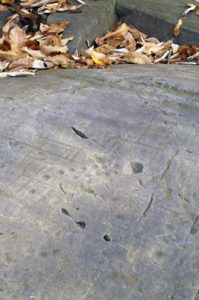 Set in the center of a large flat area abutting the rock wall demarcating the Eastern boundary, R35 is characterized by an unusual density of figures and a particular insistence on themes like schematic human figures (also called praying figures, or “orants”), dogs, and “paddles.” While the first two categories of figures are well represented throughout Foppe di Nadro (and many of them are also found on nearby rocks R29 and R27), the “paddles” emphasize the exceptional nature of this surface, making the absence of other “classical” themes – such as huts or footprints – all the more conspicuous. Note the precise distribution of marks on the surface, which seems to divide the space into thematic areas, and the presence of numerous cup-marks, some of which were carefully arranged to form a sort of “comet.” The engraving of this surface was carried out between the Neolithic and the Iron Age.
Set in the center of a large flat area abutting the rock wall demarcating the Eastern boundary, R35 is characterized by an unusual density of figures and a particular insistence on themes like schematic human figures (also called praying figures, or “orants”), dogs, and “paddles.” While the first two categories of figures are well represented throughout Foppe di Nadro (and many of them are also found on nearby rocks R29 and R27), the “paddles” emphasize the exceptional nature of this surface, making the absence of other “classical” themes – such as huts or footprints – all the more conspicuous. Note the precise distribution of marks on the surface, which seems to divide the space into thematic areas, and the presence of numerous cup-marks, some of which were carefully arranged to form a sort of “comet.” The engraving of this surface was carried out between the Neolithic and the Iron Age.
Shelter II
An archaeological excavation, carried out by the research centre “Centro Camuno di Studi Preistorici” (CCSP) between 1977 and 1979, revealed several layers of anthropization and the use of this site as a temporary shelter and burial site. The more superficial layers revealed Iron Age structures, pottery sherds, and animal bone remains. A Copper Age burial of a young man – containing a necklace of bone bezels, drilled canid and cervid teeth, shell beads and flint tools – was found at a depth of 35 cm. The oldest layer yielded three large lithic tools, attributable to the final stages of the Paleolithic era.
